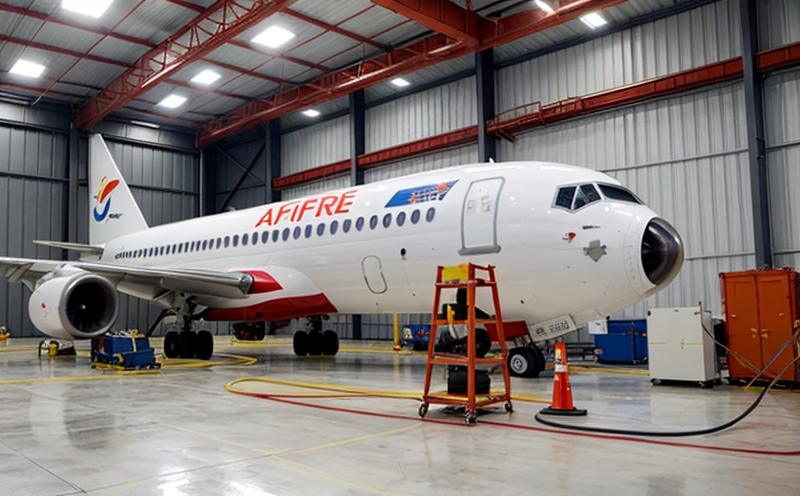Fire Reaction Testing of Aircraft Interior Fabrics
In aerospace engineering, fire safety is a paramount concern due to the high concentration of flammable materials and the need for quick evacuation in case of emergencies. Fire reaction testing of aircraft interior fabrics ensures that these materials meet stringent standards designed to minimize risk during a potential fire scenario. This service involves comprehensive evaluation of how different types of fabric react under controlled fire conditions, focusing on key parameters such as flame spread rate, smoke density, and heat release.
The process begins with careful selection and preparation of the fabric samples. These materials are typically cut into standard sizes that fit into the test chambers used for flame propagation testing. The tests are conducted in accordance with international standards like ASTM E648, which provides detailed protocols for measuring ignition propensity and flame spread behavior.
During the actual testing, fabrics are exposed to a precisely calibrated heat source, simulating the conditions of an aircraft fire. Sensors within the chamber measure various parameters including temperature rise, smoke production rate, and oxygen consumption. The data collected helps assess the flammability characteristics of each material, providing critical insights into its suitability for use in aerospace applications.
The results from these tests are then compiled into detailed reports that serve as a basis for decision-making regarding fabric selection. Compliance officers can rely on this information to ensure they meet regulatory requirements set forth by aviation authorities such as the Federal Aviation Administration (FAA) and European Union Aviation Safety Agency (EASA).
By incorporating fire reaction testing early in the design process, manufacturers and designers can identify potential issues before committing significant resources towards full-scale manufacturing. This proactive approach not only enhances safety but also contributes to reducing costs associated with redesigns or recalls.
Why It Matters
Aerospace fire incidents, though rare, can be catastrophic if they occur. Ensuring that all interior fabrics used in aircraft interiors are capable of resisting ignition and spreading flames effectively is crucial for passenger safety and crew protection. The primary goal of this testing is to reduce the likelihood of a fire starting and spreading quickly within an already confined space like an airplane cabin.
The importance of such tests extends beyond mere compliance; it reflects a commitment to upholding high standards of quality and reliability in aviation products. By adhering strictly to prescribed procedures, laboratories ensure consistent results across multiple batches of fabric, thereby promoting trust among stakeholders involved in the supply chain.
In addition to direct safety benefits, successful completion of these tests can also enhance brand reputation and competitive positioning within the market. Airlines seeking suppliers who prioritize fire safety will view compliant manufacturers more favorably, potentially leading to increased business opportunities.
Why Choose This Test
Selecting a reliable testing partner for fire reaction testing of aircraft interior fabrics is essential for several reasons. Firstly, accuracy and reliability are fundamental when dealing with safety-critical components like textiles used in aviation interiors.
- Compliance Verification: Ensures adherence to relevant international standards such as ASTM E648 and ISO 17795.
- Expertise and Experience: Our team comprises experts with deep knowledge of both the technical aspects of fire testing as well as industry best practices.
- State-of-the-Art Facilities: Utilizing advanced equipment capable of replicating real-world scenarios ensures accurate measurement of fabric performance under various conditions.
- Timely Delivery: Efficient turnaround times allow you to get feedback sooner, enabling faster iterations during product development cycles.
Competitive Advantage and Market Impact
For manufacturers operating in the aerospace sector, having robust fire reaction test capabilities offers significant competitive advantages. It demonstrates a strong commitment to passenger safety and regulatory compliance, which are increasingly becoming top priorities for airlines.
- Enhanced Reputation: A reputation built on safety and quality attracts more customers and partners willing to do business with you.
- Premium Pricing Power: Products perceived as safer often command higher prices, allowing manufacturers to maximize profit margins.
- Better Negotiation Leverage: When suppliers can offer assurance of meeting stringent safety standards ahead of competitors, they gain greater leverage in negotiations with buyers.





